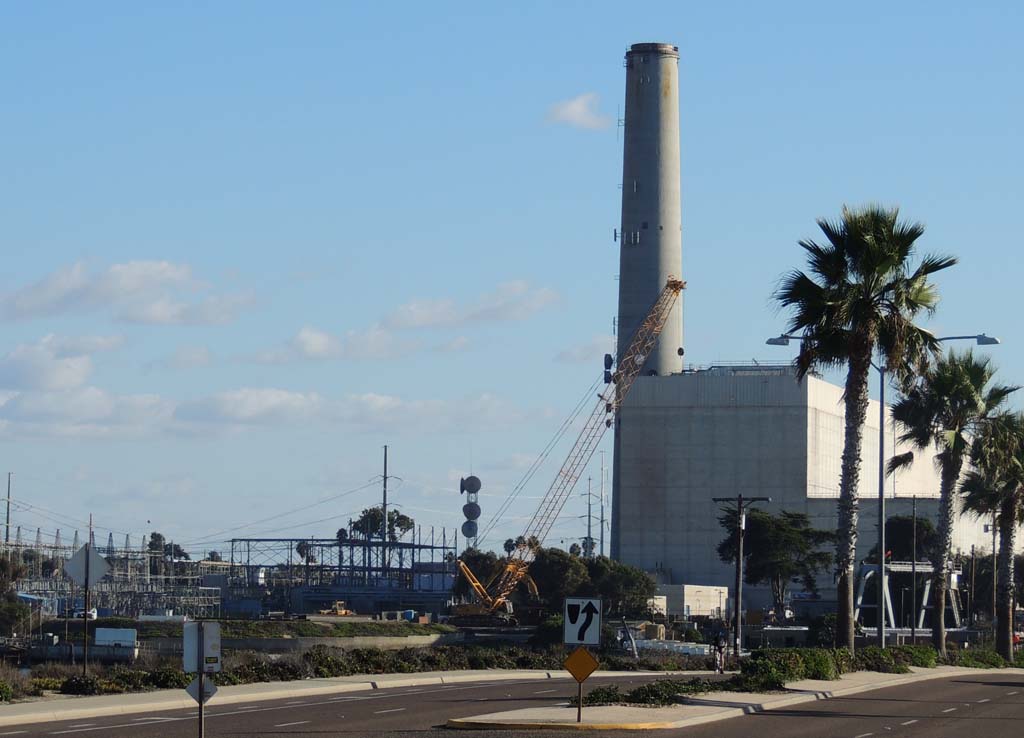CARLSBAD — Facing the inevitability of a new energy plant along its coastline, Carlsbad used its only remaining power — its ability to influence how quickly that plant would be built — to negotiate with NRG for a cleaner, smaller new one.
[amt_override]
NRG first proposed building a new energy plant, the CECP (Carlsbad Energy Center Project), to replace portions of its existing 59-year-old Encina Power Station on Carlsbad Boulevard over seven years ago. The CECP gained approval from the state in 2007.
The city adamantly opposed the new plant, citing concerns over the plant’s safety and unappealing appearance for years.
But in 2012, the Supreme Court overruled the city’s challenge.
Since that time, the power supply in San Diego County has shifted because of the early retirement of the San Onofre Nuclear Generating Station.
SDG&E proposed an agreement with NRG to purchase power from the CECP, but on the conditions that the plant would be redesigned and Carlsbad would actively support the new plant.
Carlsbad’s support would ensure that the new power plant could be built without city-imposed delay.
“While we weren’t 100 percent successful of opposing the plant the first time, it (the litigation) took a lot of time,” explained Assistant City Manager Gary Barberio at Tuesday’s city council meeting.
In pursuit of this power purchase deal, NRG has been working with the city since December to create an agreement that would secure Carlsbad’s support.
The resulting CECP deal settled upon a smaller, safer plant that produces more power and fewer air emissions than the original plant design. The agreement, which was approved by City Council, also requires NRG to tear down the entire Encina Power Station once the new plant is operational.
The new design of the CECP is a peaker plant that produces up to 600 megawatts of power located to the east of the Encina Power Station.
NRG has agreed to not operate the CECP between midnight and 6 a.m.
Unlike the original CECP plant that included 140-foot-tall stacks and would produce 480 tons of air emissions per year, the redesigned plant includes 90-foot stacks and will produce 149 tons of air emissions per year, according to data provided by NRG.
CECP’s smaller configuration will allow greater access for safety crews than the initial design.
The new CECP will not use any seawater, in contrast to Encina Power Station, which uses 635 million gallons per day. Its height and air emissions are a small fraction of current power station.
The agreement is fortified by legally binding requirements that NRG pay millions of dollars in liquidated damages to the city if it violates any of the arrangement’s conditions.
Mayor pro tem Mark Packard, Councilmember Keith Blackburn, and Councilmember Lorraine Wood voted unanimously to approve the agreement.
Mayor Matt Hall recused himself from the matter because he lives so close to the plant site. Councilmember Farrah Douglas was not present at the meeting.
Packard described the deal as, “the best compromise that could be reached for all concerned.”
“Had we not given that great fight, we would not have this great compromise,” said Blackburn.
If the agreement had been opposed by City Council, NRG would have proceeded with building the new plant as originally planned.
SDG&E’s power purchase may have also fallen through, leaving power made in Carlsbad to be potentially bought by counties outside of San Diego.



3 comments
“The resulting CECP deal settled upon a smaller, safer plant that produces more power and fewer air emissions than the original plant design. The agreement, which was approved by City Council, also requires NRG to tear down the entire Encina Power Station once the new plant is operational.”
The “deal”? Too funny. The old plant was getting shut down anyway. It doesn’t meet today’s air quality standards. All Carlsbad got in the deal was an offer to peek at the new plans. Glad everyone is so happy that the 400ft stack is coming down… it was coming down anyway. To build in Carlsbad all you need to do is show up with money. Power lines are everywhere, cancer clusters are being discovered, toxic soils from past farming, toxic soil from the piles stored at the quarry, “open spaces” are being filled with low income housing, and the Encinas plant pumps up their emissions every time the marine layer rolls in. Only the uninformed would live in Cbad. Glad I left when I did.
“The new CECP will not use any seawater, in contrast to Encina Power Station, which uses 635 million gallons per day.”
Too funny. It doesn’t “use” any. It pumps water in for cooling and then pumps it right back out. Again, only the uninformed would buy into this info.
These new peaker plants can be placed anywhere. They are going on the coast because that’s where the power lines are. The area is zoned for utilities and that’s what it’s being used for. I’m glad someone thinks they got a deal in all this. Pay no attention to the man behind the curtain.
Unfortunately, the notion that a new power plant is inevitable continues to be perpetuated, even after SDG&E and the Sierra Club told the council that the California Public Utilities Commission (CPUC) must approve a new power plant. The state Energy Commission decision is only half the equation. The CPUC does not even have an application for the Carlsbad Energy Center in front of it. In fact, the CPUC is getting ready to make a decision on whether or not any more gas plants can be built in our region. So this is far from inevitable and far from over. It’s just unfortunate that Carlsbad, after fighting a good fight, dropped out just as the cities of Del Mar, Encinitas, and Solana Beach sent letters to the CPUC saying that unnecessary fossil fuel power plants that will cost ratepayers, not millions, but billions of dollars are unwelcome here. The lights have stayed on two years without San Onofre, in large part because rapidly expanding rooftop solar and energy efficiency is reducing demand on the grid, so the need for more unsightly, polluting gas plants is obsolete.
nice job on story Rachel Jim
Comments are closed.